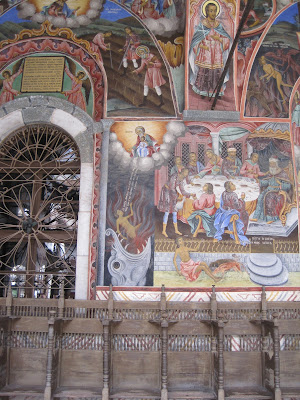We warmed to Sofia immediately from our first taxi ride to our hostel. Our driver was wearing thick thermals, smelt like Dencorub and doubled back to direct us when he noticed us wandering in the wrong direction after we got out of the cab. Like a lot of people we met in Sofia he had a small town warmth and friendliness.
Our hostel (
Hostel Mostel) was one of the best we have stayed at on the trip. Housed in a heritage building with friendly staff and a great breakfast plus basic evening meal, they even organised day trips and walks. It makes a big difference having a local to get tips from.We were so comfortable there we ended up staying for five days.


Sofia is a pretty city with amazing ornate churches and lovely parks. Most former Soviet places have removed their Soviet-era statues to out of the way corners of the city so it was interesting for us to see some of them still dotted around Sofia, often quite prominent. We had a friend asked by a local tv reporter what he thought of the Soviet statues when he was out wandering and they were even more interested in his response when they realised he was from the States. It seems there is an ongoing debate about their place in the city (Soviet-era statues, not Americans!). You can see why other places would want to cleanse a city for a fresh start after bad times but as more time passes I think the value of keeping parts of a place's history can become a worthwhile reminder and give a city depth. It often seems to happen by lucky accident in places that are cut off or where real estate is not at a premium, while cities that go through booms and remake their streets in the latest style can lose what gives a place its flavour.

The city has a calm, quiet atmosphere while still bustling. The calmness is similar to other Balkan cities and makes being in a city less of headache without all that yelling. You notice people leaning over close to each other to talk quietly instead of raising their voice. I noticed it in particular when a mix of Aussies and Brits (on a sporting trip perhaps?) swarmed off a bus in loud rowdy conversation. Being accustomed to the quiet, their loudness gave me a feeling of having my space invaded.
 |
| giant leeks and (above) tiny onions |
Because we were restricted with what we could carry on the bikes we have had to suppress our souvenir shopping instincts for most of the trip. Ironically for a former communist state we found Sofia the perfect place to shed our Spartan cycling lifestyle and go on a bit of shopping spree. They have wonderful produce markets with great nut and sweet stalls as well as local crafts. Hand made clothes and textiles are quite cheap compared to home with lovely hand-knitted woolen clothes everywhere. We visited a few specialty stores that had lovely felted rugs, wood carvings and other traditional crafts also mixed with creative modern slants on the folk art traditions. Sofia has some really creative young designers. You could also get amazing grandma made long thick-knitted vests, socks and jumpers at market stalls for little more than you would pay for the raw wool back home.
There are also fascinating antique markets and shops. Lots of Soviet-era paraphernalia is on display with stall owners happy to explain the history and meaning of different objects. Space Race era commemorative coins, Lenin youth badges and Party-issued Station Master pocket watches are the sorts of gems on offer.
I browsed a volume of excerpts taken from Jack London's novels that appeared to be made to teach people English. The foreword made it explicit the political conclusions you were expected to glean from each heavily cut section. I was surprised how heavy handed the censorship and comment was here back then. Not that I'm under any illusions about the impartiality of Western media but the slant is a lot more hidden and insidious and thus more robust. It made for strange reading as I tried to imagine how I would have felt only having access to this type of information. This system of control seems so clumsy as it makes you so curious to know what you can not get access to. Human nature will always be curious about what we are told we cannot have or is bad.









We got a tip from our hostel about a hole in wall jazz club. Back home it would be a health and safety nightmare with only candlelight and an unrailed attic area with missing floorboards and everyone smoking like chimneys. It was great. Very casual with a young guy on piano playing with an older man on violin. Our friend Egil from Sweden joined us and was also excited about the non-Germanic unsensibleness of it all.
  |
 jazz club entry and the St. Alexander jazz club entry and the St. Alexander Nevsky Cathedral Nevsky Cathedral
|

























































